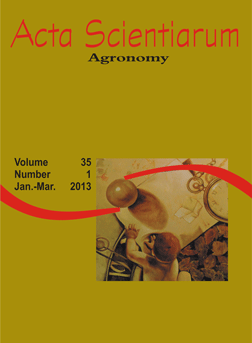<b>Growing Princesa apples under semiarid conditions in northeastern Brazil</b> - doi: 10.4025/actasciagron.v35i1.15066
Resumo
Phenological observations are some of the most sensitive data for the identification of plant species growth in regional climate conditions. Thus, an experiment was conducted from October 2008 to December 2009 to characterize the phenological stages, fruit set and fruit yield of Princesa apples grown under a semiarid climate in northeastern Brazil. Phenological data (stages) were determined in the orchard by daily observations from bud breaking until fruit ripening. The following variables were evaluated: i) fruit set, which is the relation between the number of flowers and the number of fruits (%); ii) the number of fruit per plant; iii) the fruit production per plant (kg); and iv) the fruit yield (t ha-1). Under semiarid conditions, the phenological cycle of Princesa apples is completed in 123 days and that it is possible to obtain apple yield under semiarid conditions with the pollinator cultivar. Furthermore, additional studies and more evaluation years are necessary to generate an apple production system that is reliable under semiarid conditions.
Downloads
DECLARAÇÃO DE ORIGINALIDADE E DIREITOS AUTORAIS
Declaro que o presente artigo é original, não tendo sido submetido à publicação em qualquer outro periódico nacional ou internacional, quer seja em parte ou em sua totalidade.
Os direitos autorais pertencem exclusivamente aos autores. Os direitos de licenciamento utilizados pelo periódico é a licença Creative Commons Attribution 4.0 (CC BY 4.0): são permitidos o compartilhamento (cópia e distribuição do material em qualqer meio ou formato) e adaptação (remix, transformação e criação de material a partir do conteúdo assim licenciado para quaisquer fins, inclusive comerciais.
Recomenda-se a leitura desse link para maiores informações sobre o tema: fornecimento de créditos e referências de forma correta, entre outros detalhes cruciais para uso adequado do material licenciado.




















































